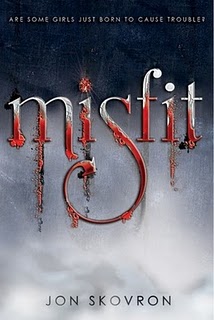 Misfit by Jon SkovronAbrams, 2011 Jael’s sixteenth birthday is approaching and she is not quite sure what to expect. She and her father have abruptly moved from city to city and country to country for her entire life, and she desperately hopes that the talk he wishes to have with her on her birthday has nothing to do with picking up and leaving yet again since she’s finally found a couple of good friends. She is also anxious to know more about her mother, who died when she was very young. Jael’s life changes forever when her father gives her a jewel handed down from her mother and which has mysterious powers. Over the next few days, Jael discovers that not only was her mother a demon, but that Jael herself is half demon with most of Hell hunting her because she is a reviled half-blood.
Misfit started off slow and initially appeared fall into a predictable "teenage girl doesn't get along with her strict single father until some sort of major event brings them closer together" storyline. Although to a certain degree Misfit indeed progressed in that way, it did it in a fun, entertaining, and largely unexpected fashion.Skovron's interpretation of demons is inventive. He draws connections between different religions and cultures to paint a complex picture of demons (many previously known to mortals as gods and goddesses), and the classical elements of nature play a large role as well. In fact, one of Jael's newfound skills is the ability to communicate with the different elements, all of which have different characteristics and which require convincing in different ways. I found this use of the elements, as well as Jael's heightened demon perception and other skills, to be creative and not overused for the sake of entertainment value.The characters in Misfit were complex and enjoyable. Jael's father was not the one-dimensional stereotypical "strict father" figure that he initially appeared to be. His personality came out mostly during the flashbacks to his time with Jael's mother rather than in the present with Jael, but it worked. Jael's friends Britt and Rob are also more than they initially appear, and the dialogue between the teenagers combined with scenes with Jael's demon uncle Dagon provided lots of humour. Overall, despite a slow start, Misfit was an engaging fantasy with an inventive interpretation of demons, fun characters, and lots of action and humour. Highly recommended. **Electronic review copy provided by NetGalley.com.
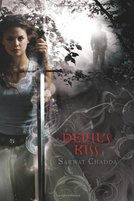 Devil's kiss by Sarwat ChaddaDisney Hyperion, 2009Billi SanGreal is the newest, youngest, and only female member of the Knights Templar, who are responsible for defending London from supernatural evils. Her father is the Master of the Templars and rules with an iron fist, especially since Billi's mother was killed over a decade ago. When Kay, Billi's childhood friend, inadvertently opens a long-closed door to legions of dark angels, the Angel of Death is summoned and a plague of biblical proportions begins. I'd been looking forward to reading this book for a while. I had read the first chapter a few months ago during a quiet afternoon at work and it sucked me right in. With a fantastic first line - "Killing him should be easy; he's only six" (p. 3) - and the first chapter following it up nicely, I had high hopes. Unfortunately, Devil's kiss didn't quite live up to my expectations.The novel is chock full of information about the Knights Templar and their history, but after a rip-roaring first chapter, a second chapter inf0-dump was a definite let-down. As much as I liked learning little factoids about Templar history, I found the delivery clunky. Turns out that Chadda is great at writing action sequences though! As in the first chapter, subsequent scenes involving battles with supernatural beings ranging from angels to vampires to Satan himself were energetic and satisfying. Devil's kiss definitely starts and ends on high notes due to this circumstance. Despite the selling of a love triangle on the back cover blurb, it didn't really exist at all in the story. This was fine by me - I didn't read the back cover until I finished the book so I had no expectations that way - but the romance that did exist seemed tenuous at best. I wonder if the friendship angle would have been a more powerful and believable connection, especially as Billi didn't have any friends her own age. However, the ending hints at a sequel which may make Chadda's choice of romance more evident.I was disappointed in the lack of use of Billi's heritage in the story. While her father is presumably British, her mother was of Pakistani descent and I kept waiting for that to factor in to the story, either via some of the non-Christian beliefs in Asia or some other link. While part of me appreciates that her cultural heritage didn't sway things one way or another, another part of me wishes it could have been used more. Given the amount of information given about the Templars, a connection from them to the ancient cultures of Asia would have been welcome. Again, perhaps the sequel will explore more in that direction.Will I read the sequel? I can see it happening. As I say, Chadda's action scenes were great and I am curious about where he takes the Templar theme in the next book.
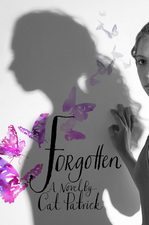 Forgotten by Cat Patrick
Little, Brown, 2011
Every morning, London Lane wakes up and cannot remember anything that has happened before. Not only is the previous day forgotten, but her entire life up to that point is unremembered. Reading letters that she writes to herself each night, each morning London gets caught up on what is going on in her life: school, friendships, and a very cute new boyfriend named Justin. The thing is, London can "remember" events that occur in the future - such as upcoming spring breaks with her best friend - but Justin doesn't appear to be there. When she begins dreaming of a funeral she fears that it may be connected to Justin, but how? And whose funeral is it?
Pros:
Fantastic premise.
Awesome mother.
Dreamy love interest.
Mysterious family history.
I loved the idea of amnesia combined with "remembering" the future, which is a helpful plot point in the sense that it allows London to know her mother and best friend. It also creates tension with London's dream of the funeral and working out when it happened and who died, as well as not knowing who Justin is because he's not in her memories of upcoming events. I found the beginning of the book to be confusing though, and didn't know what was going on with London and her memory for the first couple of chapters. I imagine that it would be obvious if I re-read those chapters, but when I wasn't familiar with London's situation I found it confusing.
For the most part, I liked London: she could be a bit dramatic for my taste at times, but if I couldn't remember my past I'd be sensitive to trust issues as well. She must also get up ridiculously early if she manages to read all her notes every morning! Her mother was solid and amazingly patient, and watching London repeatedly adjust to Justin's presence - it must be very odd to be in a relationship with someone you only know from notes you wrote - was entertaining.
Speaking of the notes, I appreciated how Patrick addressed the malleability of the present in London's life. For example, London can see how an acquaintance of hers will get hurt after dating a specific boy, so she works with what she knows to try to save her from that fate. Because she is so reliant on her notes, if London doesn't write down specific things about her day she will never know what happened or didn't happen. Seeing London play with this knowledge, which was a way for her to have power over her situation, was fascinating and produced unexpected results.
Cons:
London sometimes sounded like a 80-year-old.
There were a few passages that jolted me right out of the story, such as "the wind sets flight to my bright auburn locks" (p. 8 of galley) and "the thought of [Justin] serving as older brother to these two precious ladies feels right" (p. 73 of galley). What 16-year-old uses the word locks instead of hair? To say nothing of calling 2-year-old twin girls "precious ladies," which I'm guessing may come from the author being a mother of twin girls. Although I'm sure both the author's daughters and Justin's sisters are indeed precious, I have a lot of trouble believing that a teenage girl would string that particular phrase together.
All told, Forgotten is a compelling debut from Cat Patrick and I look forward to more books from her in years to come.
**Galley provided by publisher.
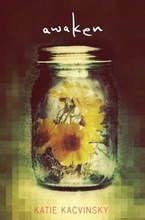 Awaken by Kate KacvinskyHoughton Mifflin Harcourt, 2011It is the year 2060, and Madeline is seventeen and in her final year of Digital School (DS). In fact, her father is the creator of DS, which allows all American children to have free education via computers in the comfort of their own homes, and even adults socialize and work entirely online. Madeline's father doesn't make her life easy due to an anti-DS incident that happened when Madeline was fifteen, so she has a probation officer and is under constant surveillance. When she meets the mysterious Justin at an offline study session, she has no idea how much the life she takes for granted is about to flip upside down. I had a great time reading Awaken. For one thing, I have a particular weakness for dystopian literature so this was right up my alley. What I found interesting was how similar Kacvinsky's imagining of 2060 is to today's world and that it initially threw me off a bit. I'm so accustomed to scenarios set 50 years into the future being full of flying cars (which actually show up but as a surprising invention and not a daily occurrence) and helpful household robots that the subtlety of Kacvinsky's vision was initially a bit of a let-down. However, it grew on me and is ultimately far more realistic and made the cultural developments that much more stark. It also allowed for one my favourite scenes in the book, in which Madeline encounters real grass and trees for the first time in her life. Madeline has many firsts in Awaken, including first offline study group, first ride in a car, first time hearing live music, and first love. The vast majority of these firsts - if not all of them - are brought about by Justin, with whom Madeline is infatuated from the beginning. Madeline's inner dialogue about his friendship is entertaining and ratchets up the sexual tension, and combining that with watching Madeline and Justin warily circle each other and do their best not to succumb to their feelings made this one of the steamiest dystopian novels I can recall reading. As the Brits say, "Phwoar!" Awaken is populated with many compelling characters. Madeline's mother makes a strong early appearance and, while she doesn't play a large role, is an effective presence with her values that lean strongly toward the pre-digital. By contrast, Madeline's father plays his cards very close to his chest and is deeply invested in his work, and his relationship with Madeline is rocky at best. One of my favourite characters was Clare, a friend of Justin's who adds much-needed lightness to the proceedings, as does Justin's monumentally charming family. More than just a romance in a futuristic world, Awaken presents a vision of the future that may well come to pass and I will be handing it to fans of Uglies and Feed without hesitation. **Electronic galley provided by publisher via netGalley.
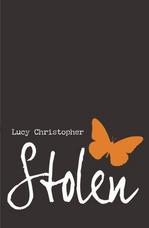 Stolen by Lucy Christopher
The Chicken House, 2010
On a trip to Vietnam with her parents, 16-year-old Gemma meets an attractive and vaguely familiar guy in a Bangkok airport cafe. What she thinks is an innocent flirtation quickly turns into a drug-induced blur that ends when she wakes up on a bed in a small room a few days later. It turns out that she's been taken to a remote part of the vast Australian desert and her captor, Ty, intends to keep her there with him forever.
Stolen is written as a letter from Gemma to Ty as she looks back on the beginning and development of their relationship, so as a reader I spent time in Gemma's head as the kidnapping and subsequent events occur but with the buffer of a reflective distance. This distance has an ebb and flow to it and while some events are told almost like a narrative, others are very immediate. To Lucy Christopher's credit, I didn't notice this flux as I was reading and was simply drawn deeply into the story.
What I find remarkable about Stolen is how the author managed to keep tensions high even when not much is happening. True, Gemma makes some dramatic escape attempts, but for the most part she is watching Ty's movements and slowly absorbing the situation she finds herself in. I found myself turning pages quickly to find out what happens next, and small things (like feeding the chickens) took on a lot of significance as a result.
Gemma's emotional journey throughout the book is wonderfully depicted. Her thoughts and feelings are on display and her actions reflect those internal struggles. Her relationship with Ty develops and his motivations and history are slowly revealed, and he is not in any way a cookie-cutter character. Both Gemma and Ty have a lot of dimension and complexity, and the stark and brutal Australian desert setting is a character in its own right.
My one criticism is that the end felt weak to me and almost like a cop-out (I won't spoil it for you though). I discussed this with a friend of mine who had recommended Stolen to me, and she made the considered point that it was the only possible conclusion. I beg to differ, however, and I feel like the book could have ended far more ambiguously. I will say that Gemma's emotional reactions at the end of the book were consistent and realistic, which I greatly appreciated.
While I've read a few books about teen kidnappings, this one has twists and complexities that I had not yet encountered.
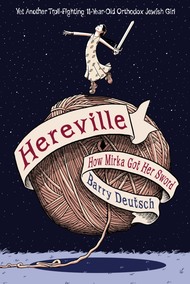 Hereville: how Mirka got her sword by Barry Deutsch
Amulet Books, 2010
Mirka wants to be a dragonslayer, but that profession doesn't exactly jive with her Orthodox Jewish upbringing. One day on her way to school, Mirka comes across a spectacular building with a woman floating in the front yard. When she tells her sisters and brother, they don't believe her so she finds the building again and picks a giant grape. Although the grape doesn't bite her, the giant pig who now follows her around might! How can she possibly get rid of it?
This graphic novel is a whole lot of fun, and I really appreciated how her religion and lifestyle played a large yet not oppressive role. Mirka's Yiddish sayings are defined at the bottom of the page, her family's beliefs are shown and explained clearly, and the conflict between her dream to be a dragonslayer and her family's beliefs was made evident. In fact, the tagline on the cover of the book really captures the sentiment throughout: "Yet another troll-fighting 11-year-old Orthodox Jewish girl." What's not to love about that?
The drawings themselves are line drawings with black ink, greys, and apart from the night-time scenes in grey-blues, the only colours are beige and an orange shade. I enjoyed Deutsch's style, which is fairly simple but with lots of expression and movement. There is a wide variety of panel layouts throughout, but they would be easy to follow and understand for even those who are new to graphic novels. I particularly adored how he drew the troll, and appreciated the back matter in which Deutsch showed how many iterations of the troll he went through before deciding on the final design.
Hereville should hold great appeal for upper elementary or middle grade students who like fantasy, or fans of graphic novels with strong female protagonists like Rapunzel's Revenge.
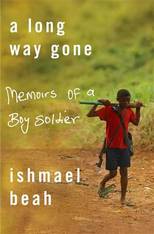 A long way gone: memoirs of a boy soldier by Ishmael Beah
Douglas & McIntyre, 2007
Ishmael Beah was 12 when a rebel army invaded his village in Sierra Leone. He spent many months running and trying to stay ahead of the rebels who were ruthlessly destroying and killing everything in their path. Since many of the rebel soldiers were young boys, Ishmael and his companions were met with fear almost everywhere they went, and as a result had to survive on their own for months on end.
Less than a year after leaving his village on the run, Ishmael was picked up by the government army and pressed into service. Learning to eat an entire meal in under a minute was perhaps the least violent skill he learned at the camp, and fighting battles and invading villages under the influence of drugs soon became a way of life. A long way gone is a terrible, moving, and ultimately heartwarming tale of one boy's life as a child running from the rebels and fighting them in battle and, later, being rehabilitated.
A long way gone opens masterfully, with a brief anecdote about Ishmael Beah's U.S. high school classmates thinking it was cool how he had seen "people running around with guns and shooting each other." I've heard a similar sentiment expressed many times in the libraries I work in, especially from boys who are the same age as Beah was when he was running and fighting for his life. It is a testament to Beah that he could smile at his classmates' ignorance.
In fact, the whole book is a testament to Beah, although he does not glorify himself nor try to make himself appear any different from other boy soldiers: as a squad leader in the army, he commanded other boys and performed horrific acts himself and was certainly an active participant. He seems to attribute his rehabilitation as much to luck as anything else, and describes his painful recovery in frank terms. He objectively describes his fear, frustration, annoyance, anger, and joy throughout.
While the book is not gratuitously violent, there are definitely some graphic descriptions of village invasions, battles, and merciless revenge. It is my view that it is as tastefully done as was possible and I was always aware that for every horror described in the book, Beah likely experienced hundreds more.
Yes, this is a bleak book, but it is also a tale of the possibility of recovery for children who have lived through horrors that many of us cannot even imagine.
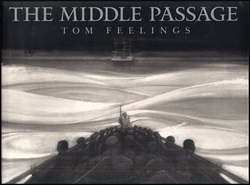 The Middle Passage: White Ships | Black Cargoby Tom Feelings
Dial Books, 1995
Twenty years in the making, The Middle Passage wordlessly depicts the horrifying journey across the Atlantic that millions of African captives were forced to take during the slave trade.
I was first introduced to The Middle Passage during a young adult literature class I took during the course of my MLIS, and it hasn't left my mind since. Not an easy book to procure, I luckily found a copy on a used book website and purchased it for the high school library I manage, and I view it as a highly prized part of the collection.
The Middle Passage is not an easy book to experience. I say 'experience' because while wordless, it is immensely powerful and often difficult to view. In fact, the horror that Feelings portrays throughout dozens of black and white paintings cannot possibly be put into words. Scenes of violence, abuse, rape, murder, and death abound, yet while Feelings' artistry reveals enough to make clear what is happening in the paintings, the images are not graphic in the sense that some violence in films and books are graphic. What is shown is enough to clearly indicate what is happening and the blanks are easily, uncomfortably, filled in.
There is a lot to absorb in The Middle Passage. The white men who abduct the African captives are so pale as to be ghostly. Scenes of the ship's hold, with hundreds of shackled men, women, and children crammed into tiny spaces where many fall ill and perish, are unimaginable. The spirit of the slaves emerges strongly, with rage and mutinous intentions made clear.
It is difficult to adequately describe The Middle Passage. It is a book that proves that not only is a picture worth a thousand words, but worth more than words can say.
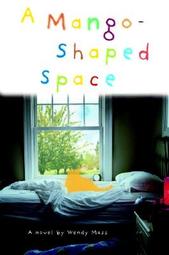 A Mango-shaped space by Wendy MassLittle, Brown, 2005For her entire life, 13-year-old Mia has seen colours and shapes that nobody else can. For Mia, every noise, letter, and number has a specific colour and shape. In fact, she didn't name her cat Mango because of his orange eyes, but because his purr is the same orange colour as the flesh of a mango. It sounds like magic, but ever since the day in third grade when she wrote numbers on the blackboard in their correct colours and was called a freak by classmates, she has kept this a secret and tried her best to be "normal." When she starts failing her algebra and Spanish classes because the colours she sees make it difficult for her to understand, Mia tells her family. After seeing a doctor and a psychotherapist, Mia finally meets someone who can tell her what she needs to know: that she has something called synesthesia and she's not the only one. This opens a whole new world to Mia, but unfortunately there are prices to pay. My initial impression of A Mango-shaped space was that Mia's voice was too old for someone who is 13. While I felt that Wendy Mass's descriptions of the colours and shapes Mia sees were very effective and put me inside her head, the occasional phrase in the first couple of chapters would take me out of the story. I just couldn't imagine Mia actually saying of her older sister "[she] dropped me like a bag of piping-hot microwave popcorn" (p. 7). Fortunately, this impression only applied to the early, more descriptive chapters and soon I was swept up in Mia's experience. This is essentially a coming-of-age book that addresses friendship, a first kiss, family relationships, and grief. However, it is framed within Mia's discovery of synesthesia and figuring out how to deal with it and people's reactions to it and the fact that she kept it a secret for so long. It was remarkable how Wendy Mass described Mia's experience of synesthesia throughout the book, and it certainly increased my understanding of a rare and not often spoken-of human condition.
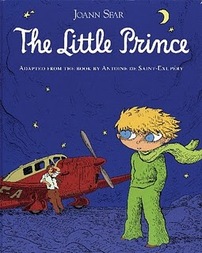 The little prince by Joann Sfar, adapted from the book by Antoine de Saint-Exupéry
Houghton Mifflin, 2010
A man is stranded in the desert with a broken-down airplane. He is asleep one night when the little prince awakes him with a request: "Please. Draw me a sheep." Thus begins a friendship between a human and a small alien boy who wants to return to his home planet and the flower that he loves.
Sfar's graphic adaptation of the classic book by de Saint-Exupéry is very faithful to the original text. True, the entirety of the text is not included, but many of the conversations, the planets that the little prince visits, and details like the drawings that the man does are the same. I haven't done a strict adaptation-to-original comparison, but a quick skim through de Saint-Exupéry's book indicates that the essence of his tale is contained in Sfar's work.
The little prince looks quite a bit different in Sfar's adaptation: he has huge eyes and a football-shaped head. The tousled blond hair and scarf remain the same, but Sfar's version of the little prince is more alien-looking than de Saint-Exupéry's. Of course, the little prince is an alien, and his appearance grew on me throughout the book and now I can hardly picture him otherwise.
Sfar's style of illustration is distinctive. There is an informal, almost sketch-like quality to his drawings, such as scribbles to indicate texture on the ground. I'm not sure if there is an actual straight line in the entire book, but the drawing are anything but haphazard. The angles Sfar uses, especially on the planets that the little prince visits, vary widely and give a sense of the space and atmosphere at each planet. I found his interpretations of the aliens and other characters strange and fascinating, especially the king on the first planet with his elephantine nose and the fox on Earth whose ears look identical to his fluffy tail. Admittedly, Sfar's style took a few pages for me to get used to, but I ended up really liking it.
While not a replacement for Antoine de Saint-Exupéry's work, Sfar's graphic novel adaptation of The little prince is a lovely introduction to or a lovely reminder of a timeless story that holds a spot in many hearts.
|










 RSS Feed
RSS Feed